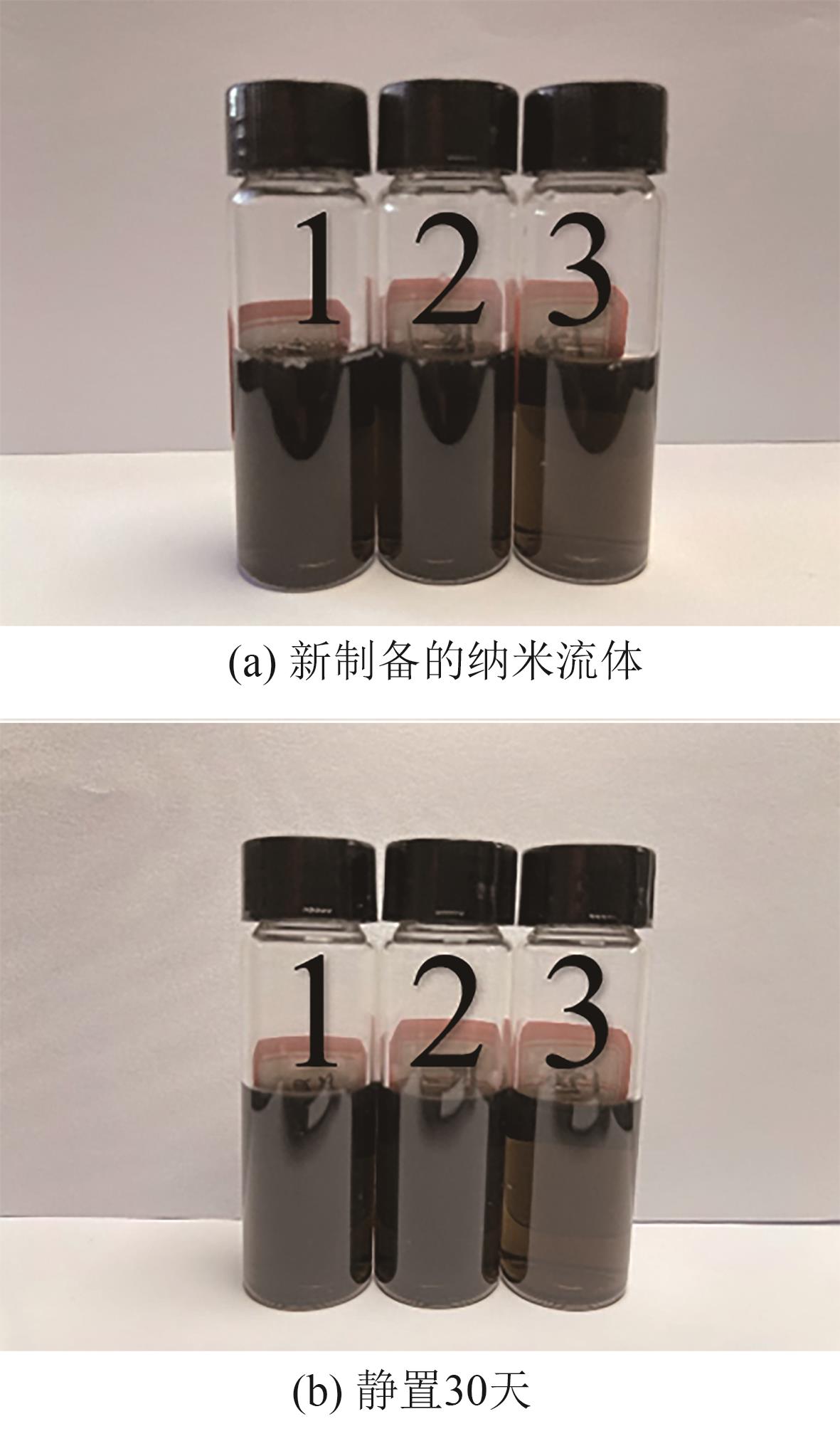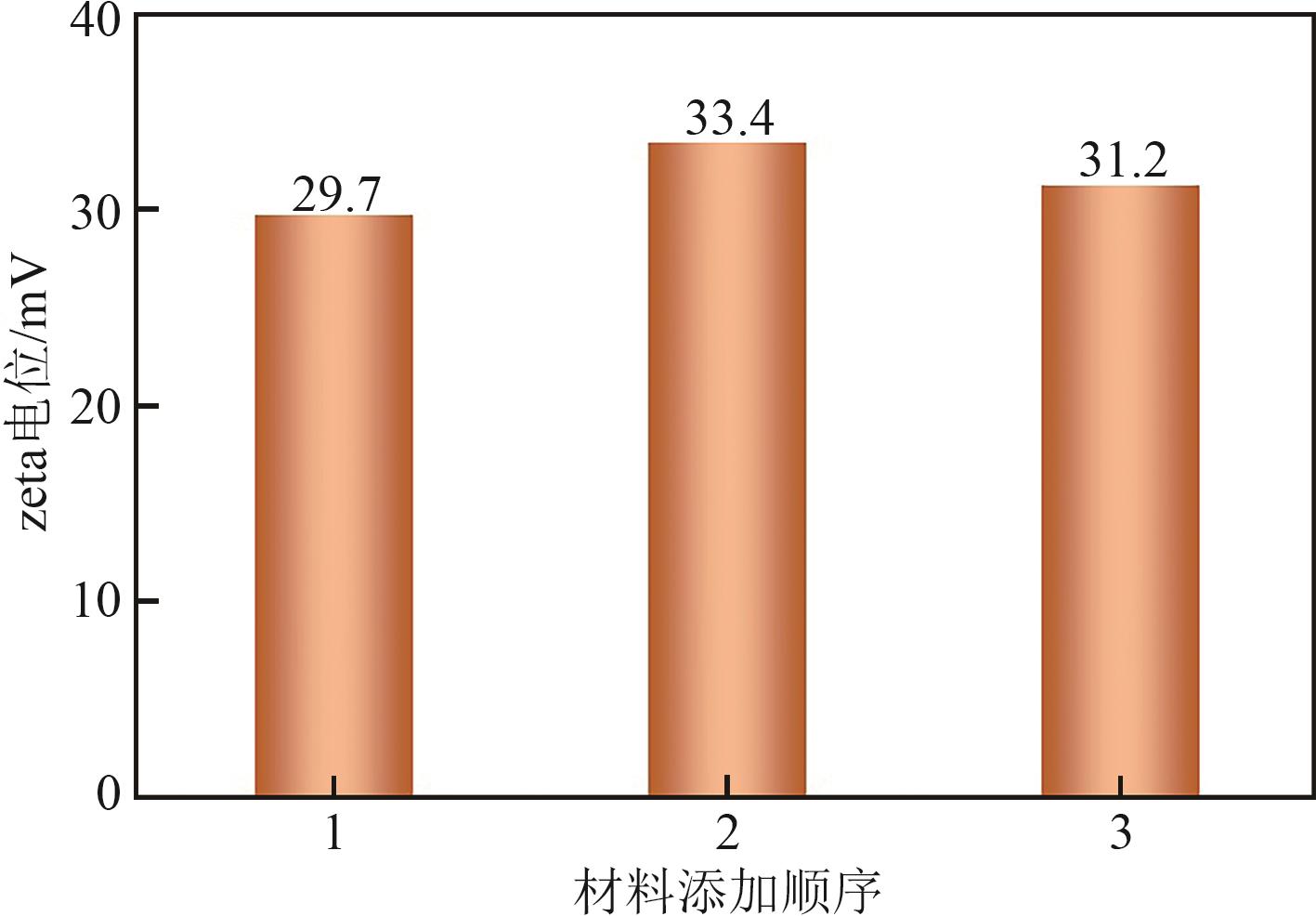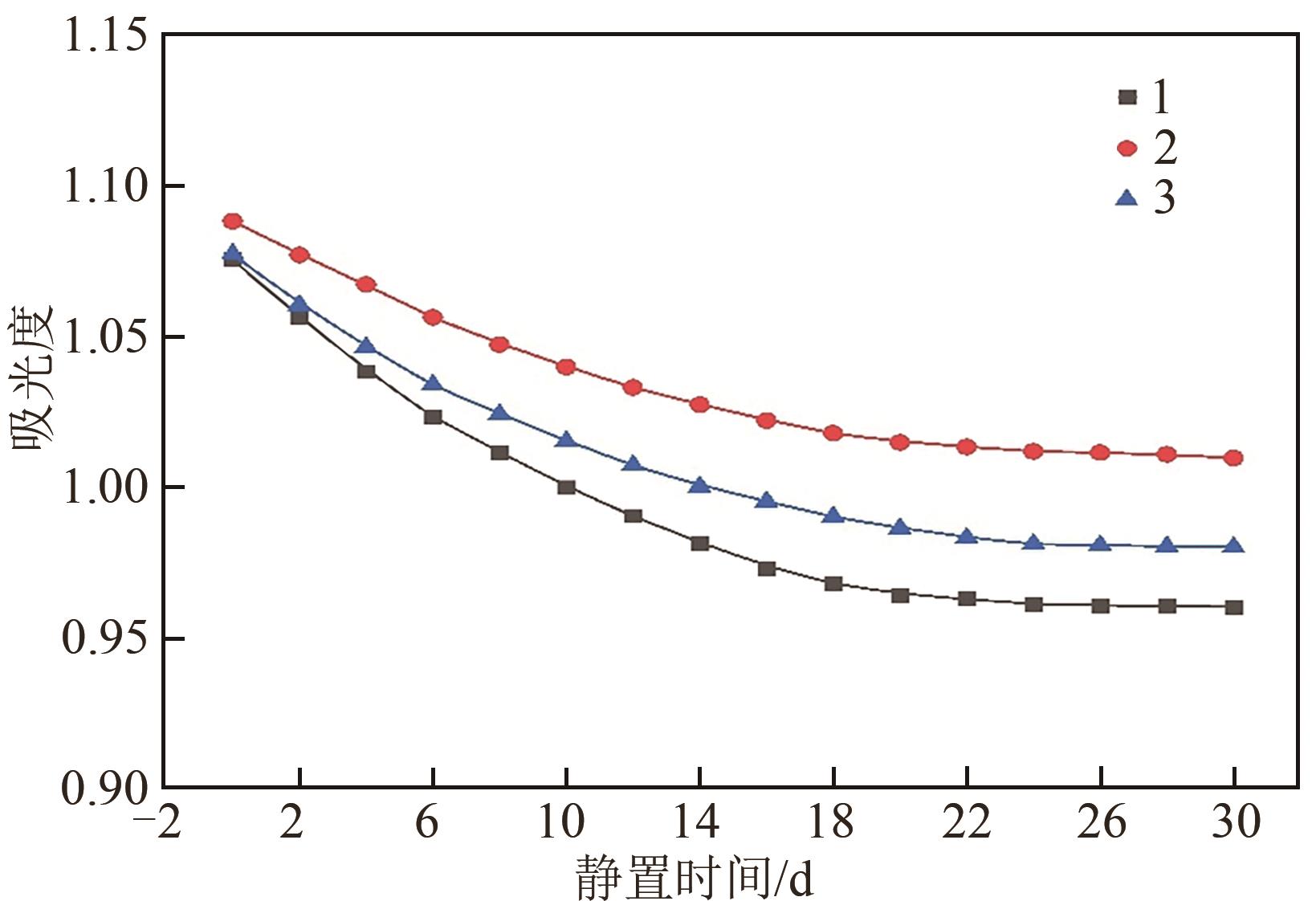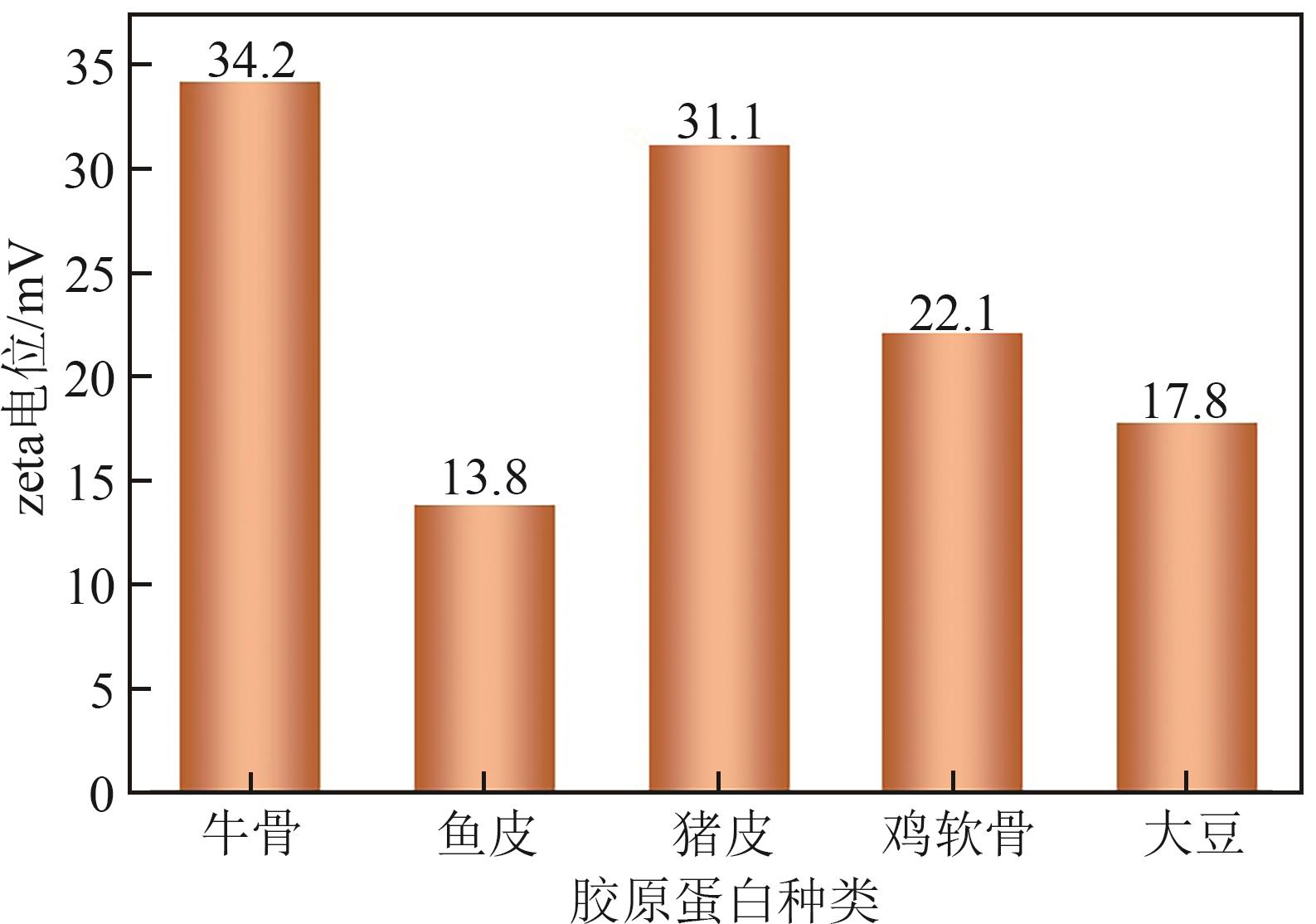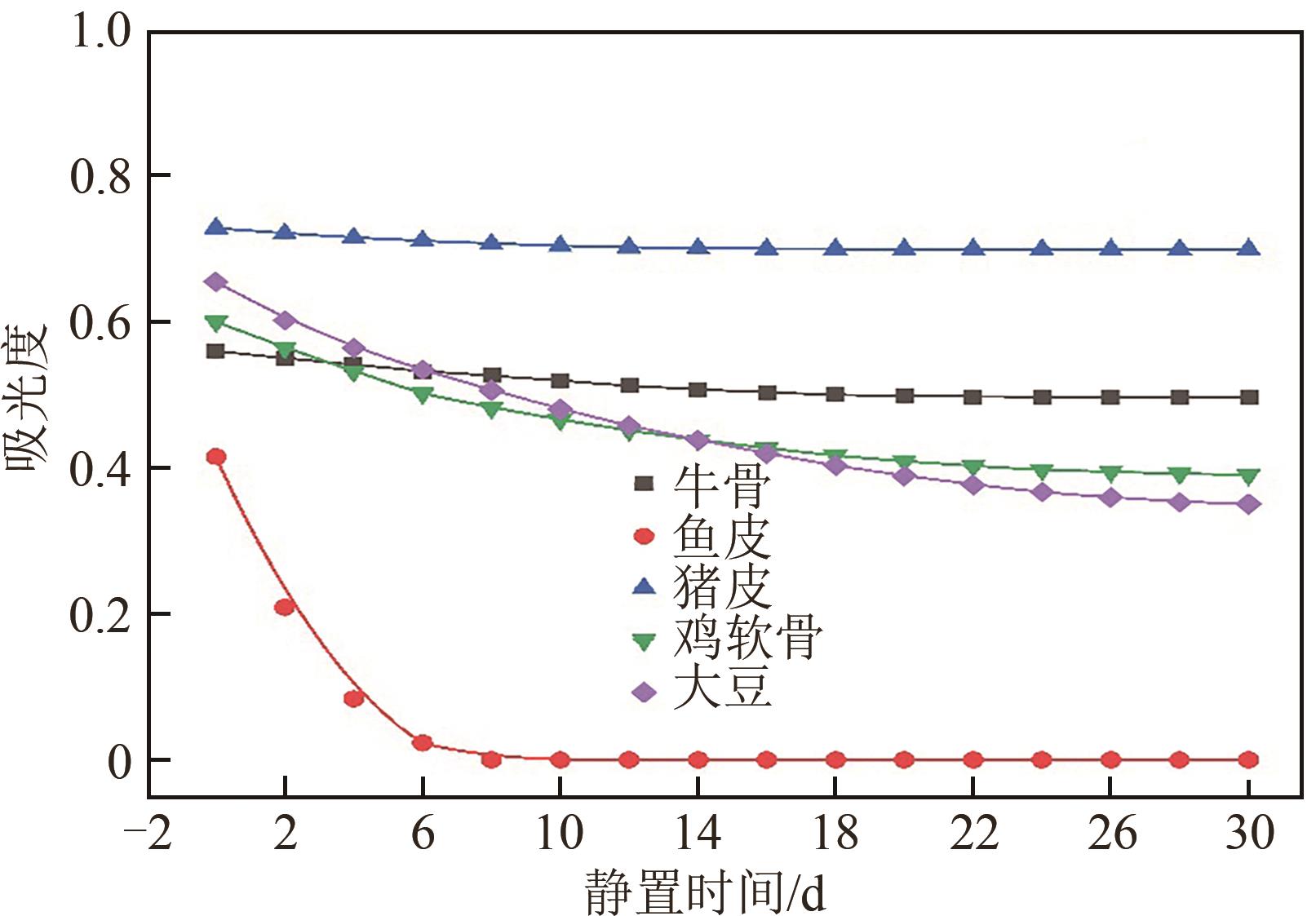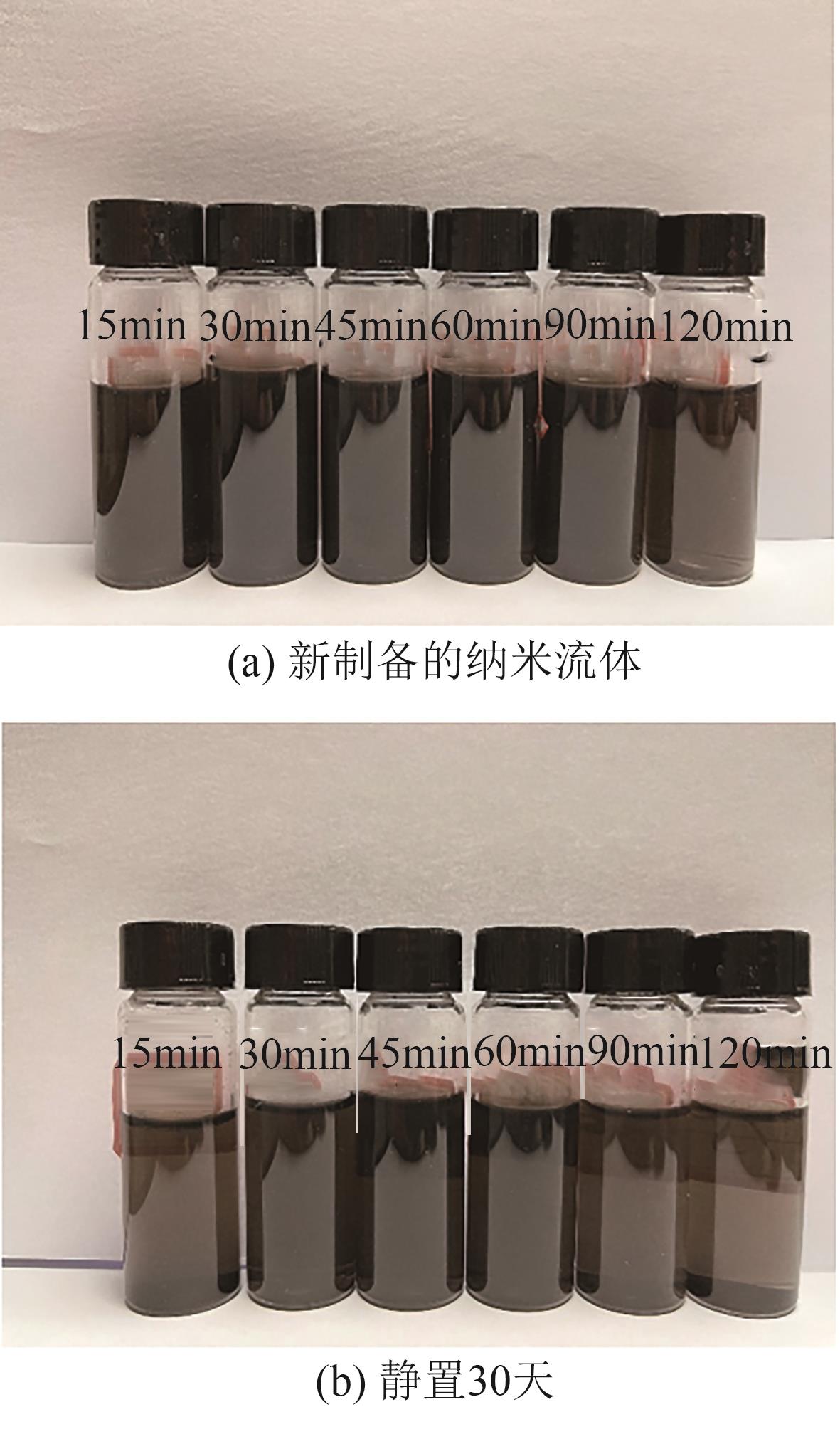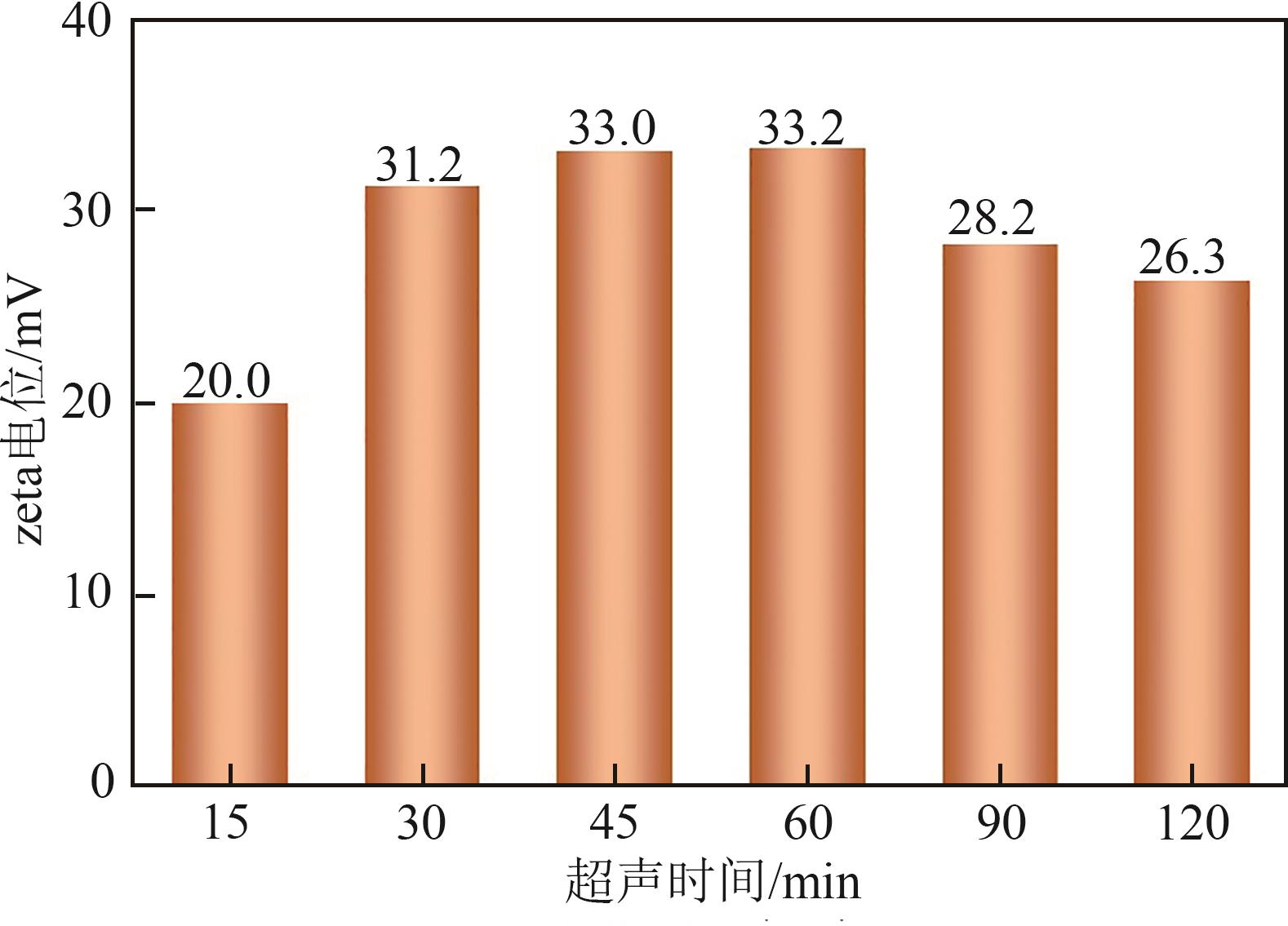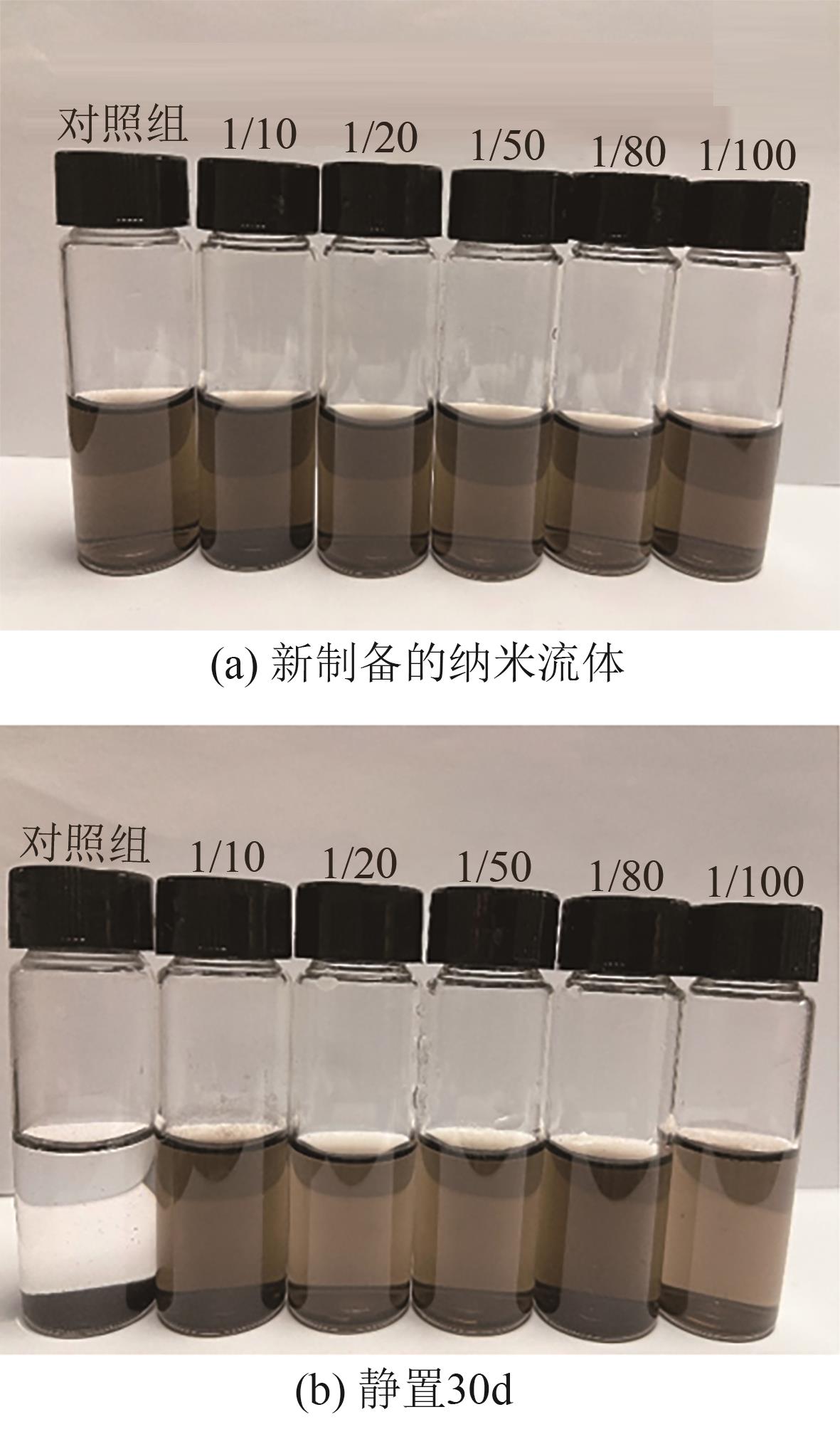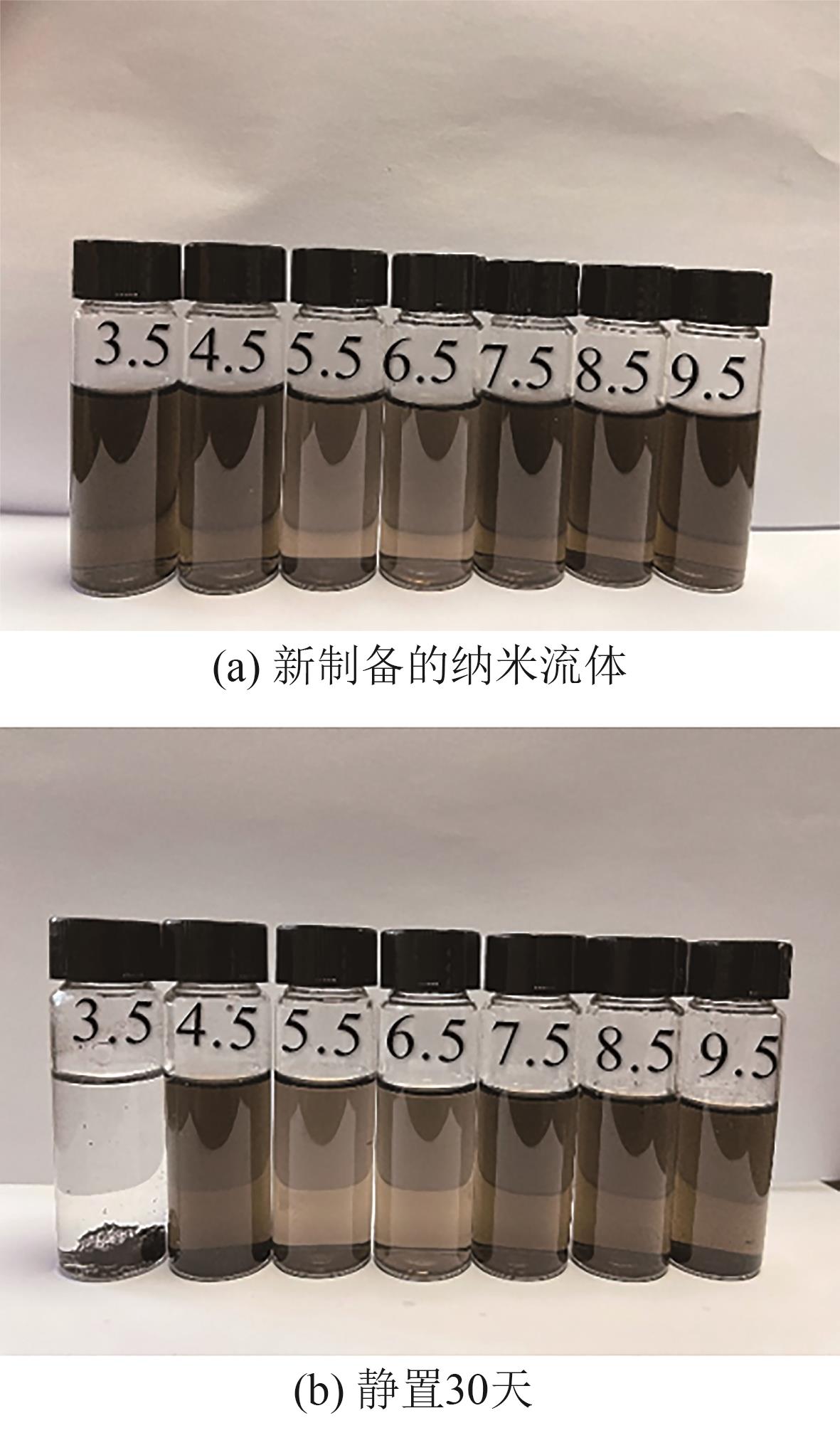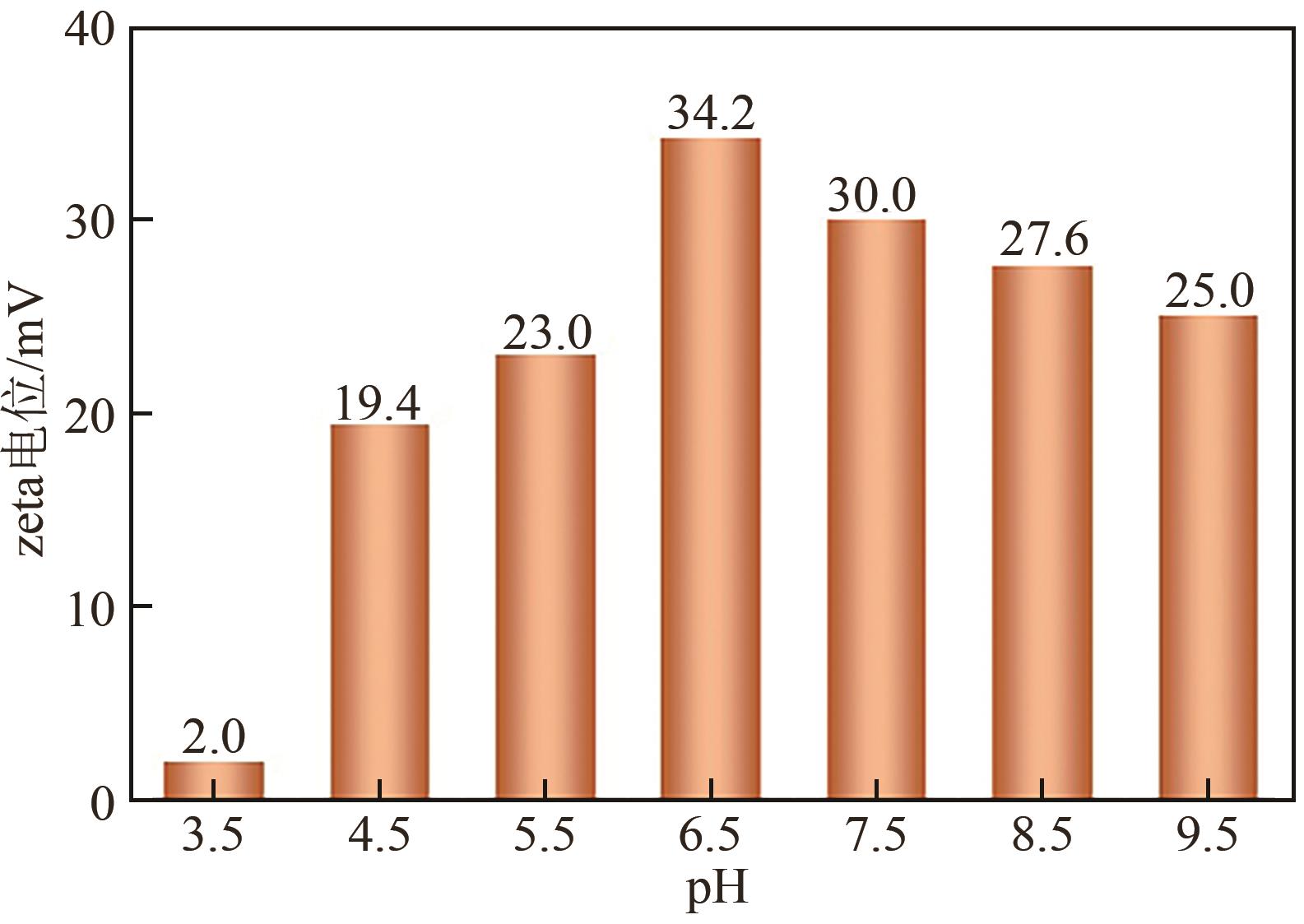Chemical Industry and Engineering Progress ›› 2024, Vol. 43 ›› Issue (4): 1944-1952.DOI: 10.16085/j.issn.1000-6613.2023-0561
• Materials science and technology • Previous Articles
Experimental study on the preparation and stability of water-based carbon black-collagen nanofluids
LI Kai( ), WEI Helin, ZUO Xiahua, YANG Weimin, YAN Hua, AN Ying(
), WEI Helin, ZUO Xiahua, YANG Weimin, YAN Hua, AN Ying( )
)
- College of Mechanical and Eelectrical Engineering, Beijing University of Chemical Technology, Beijing 100029, China
-
Received:2023-04-10Revised:2023-05-15Online:2024-05-13Published:2024-04-15 -
Contact:AN Ying
水基炭黑-胶原蛋白纳米流体制备及稳定性实验
- 北京化工大学机电工程学院,北京 100029
-
通讯作者:安瑛 -
作者简介:李凯(1998—),男,硕士研究生,研究方向为纳米流体光热转换。E-mail:13834742296@163.com。 -
基金资助:国家自然科学基金(52176175)
CLC Number:
Cite this article
LI Kai, WEI Helin, ZUO Xiahua, YANG Weimin, YAN Hua, AN Ying. Experimental study on the preparation and stability of water-based carbon black-collagen nanofluids[J]. Chemical Industry and Engineering Progress, 2024, 43(4): 1944-1952.
李凯, 魏鹤琳, 左夏华, 杨卫民, 阎华, 安瑛. 水基炭黑-胶原蛋白纳米流体制备及稳定性实验[J]. 化工进展, 2024, 43(4): 1944-1952.
share this article
Add to citation manager EndNote|Ris|BibTeX
URL: https://hgjz.cip.com.cn/EN/10.16085/j.issn.1000-6613.2023-0561
| 原材料 | 生产厂家 | 规格/尺度 |
|---|---|---|
| 炭黑 | 美国CABOT公司 | 15nm |
| 胶原蛋白 | 尚宏生物科技有限公司 | 500g/袋 |
| 去离子水 | 来源LD-UPW-20超纯水机 | 电导率<5μS/cm |
| 原材料 | 生产厂家 | 规格/尺度 |
|---|---|---|
| 炭黑 | 美国CABOT公司 | 15nm |
| 胶原蛋白 | 尚宏生物科技有限公司 | 500g/袋 |
| 去离子水 | 来源LD-UPW-20超纯水机 | 电导率<5μS/cm |
| 仪器名称 | 生产厂家 | 仪器型号 |
|---|---|---|
| 电子天平 | 上海海康电子仪器厂 | FA214 |
| 超声波细胞破碎机 | 宁波新芝生物科技股份有限公司 | Scientz IID |
| 紫外-可见分光光度计 | 南京菲勒仪器有限公司 | G-9PC,PHILES |
| 超声波清洗机 | 深圳福洋科技集团有限公司 | F-030S |
| 磁力搅拌仪 | 常州金坛良友仪器有限公司 | HJ-2A |
| zeta 电位及粒度分析仪 | 美国布鲁克海文仪器公司 | ZetaPALS |
| 仪器名称 | 生产厂家 | 仪器型号 |
|---|---|---|
| 电子天平 | 上海海康电子仪器厂 | FA214 |
| 超声波细胞破碎机 | 宁波新芝生物科技股份有限公司 | Scientz IID |
| 紫外-可见分光光度计 | 南京菲勒仪器有限公司 | G-9PC,PHILES |
| 超声波清洗机 | 深圳福洋科技集团有限公司 | F-030S |
| 磁力搅拌仪 | 常州金坛良友仪器有限公司 | HJ-2A |
| zeta 电位及粒度分析仪 | 美国布鲁克海文仪器公司 | ZetaPALS |
| 1 | 李艳, 洪文鹏, 牛晓娟, 等. 水基Ag@TiO2纳米流体液滴光热蒸发特性研究[J]. 工程热物理学报, 2022, 43(6): 1467-1472. |
| LI Yan, HONG Wenpeng, NIU Xiaojuan, et al. Investigation on photothermal evaporation characteristics of water-based Ag@TiO2 nanofluid droplets[J]. Journal of Engineering Thermophysics, 2022, 43(6): 1467-1472. | |
| 2 | HAZRA S K, GHOSH S, NANDI T K. Photo-thermal conversion characteristics of carbon black-ethylene glycol nanofluids for applications in direct absorption solar collectors[J]. Applied Thermal Engineering, 2019, 163: 114402. |
| 3 | 张俊, 李苏巧, 彭林明, 等. 纳米流体强化气液传质研究进展[J]. 化工进展, 2013, 32(4): 732-739. |
| ZHANG Jun, LI Suqiao, PENG Linming, et al. Progress in research on gas-liquid mass transfer enhancement of nanofluids[J]. Chemical Industry and Engineering Progress, 2013, 32(4): 732-739. | |
| 4 | 王亚辉, 罗延旭, 刘耀, 等. 纳米流体研究进展[J]. 能源工程, 2022, 42(2): 7-16. |
| WANG Yahui, LUO Yanxu, LIU Yao, et al. Review of research progress of nanofluids[J]. Energy Engineering, 2022, 42(2): 7-16. | |
| 5 | 刘宇龙, 佘跃惠. 纳米粒子的分散稳定机制及影响因素研究[J]. 化工新型材料, 2022, 50(S1): 298-302, 311. |
| LIU Yulong, SHE Yuehui. Study on dispersion stability mechanism and influencing factors of nanoparticles[J]. New Chemical Materials, 2022, 50(S1): 298-302, 311. | |
| 6 | 洪欢喜, 武卫东, 盛伟, 等. 纳米流体制备的研究进展[J]. 化工进展, 2008, 27(12): 1923-1928. |
| HONG Huanxi, WU Weidong, SHENG Wei, et al. Research progress of preparation of nanofluids[J]. Chemical Industry and Engineering Progress, 2008, 27(12): 1923-1928. | |
| 7 | 马明琰, 翟玉玲, 轩梓灏, 等. 三元混合纳米流体稳定性及热性能[J]. 化工进展, 2021, 40(8): 4179-4186. |
| MA Mingyan, ZHAI Yuling, XUAN Zihao, et al. Stability and thermal performance of ternary hybrid nanofluids[J]. Chemical Industry and Engineering Progress, 2021, 40(8): 4179-4186. | |
| 8 | KIM Hyun Jin, LEE Seung-Hyun, LEE Ji-Hwan, et al. Effect of particle shape on suspension stability and thermal conductivities of water-based bohemite alumina nanofluids[J]. Energy, 2015, 90: 1290-1297. |
| 9 | SUSEEL Jai Krishnan S, NAGARAJAN P K. Influence of stability and particle shape effects for an entropy generation based optimized selection of magnesia nanofluid for convective heat flow applications[J]. Applied Surface Science, 2019, 489: 560-575. |
| 10 | 沈向阳, 李国铭, 陈嘉澍, 等. Al2O3/丙二醇纳米流体的稳定性研究及热物性测量[J]. 低温与超导, 2021, 49(9): 88-94. |
| SHEN Xiangyang, LI Guoming, CHEN Jiashu, et al. Study on stability of Al2O3/propylene glycol nanofluids and its thermophysical property measurement[J]. Cryogenics & Superconductivity, 2021, 49(9): 88-94. | |
| 11 | 恭飞, 吴张永, 王雪婷, 等. SiC纳米流体制备及属性仿真实验研究[J]. 硅酸盐通报, 2020, 39(3): 986-994, 1001. |
| GONG Fei, WU Zhangyong, WANG Xueting, et al. Experimental study on preparation and property simulation of SiC nanofluids[J]. Bulletin of the Chinese Ceramic Society, 2020, 39(3): 986-994, 1001. | |
| 12 | 王晗. 管式太阳能集热器高效集热介质及综合利用方法研究[D]. 北京: 北京化工大学, 2018. |
| WANG Han. Study on efficient working fluids and comprehensive utilization methods of tubular solar collector[D]. Beijing: Beijing University of Chemical Technology, 2018. | |
| 13 | 熊亚选, 宋超宇, 药晨华, 等. 纳米流体稳定性研究综述[J]. 华电技术, 2021, 43(7): 68-74. |
| XIONG Yaxuan, SONG Chaoyu, YAO Chenhua, et al. Review on the stability of nanofluids[J]. Huadian Technology, 2021, 43(7): 68-74. | |
| 14 | CHUNG S J, LEONARD J P, NETTLESHIP I, et al. Characterization of ZnO nanoparticle suspension in water: Effectiveness of ultrasonic dispersion[J]. Powder Technology, 2009, 194(1/2): 75-80. |
| 15 | 丁洁, 王平, 张本国, 等. 混合基纳米流体在汽车散热器中的稳定性及传热特性[J]. 科学技术与工程, 2019, 19(1): 196-206. |
| DING Jie, WANG Ping, ZHANG Benguo, et al. Stability and heat transfer characteristics in automotive radiators of mixed-based nanofluids[J]. Science Technology and Engineering, 2019, 19(1): 196-206. | |
| 16 | ISMAIL H, SULAIMAN M Z, AIZZAT M H. Qualitative investigations on the stability of Al2O3-SiO2 hybrid water-based nanofluids[J]. IOP Conference Series: Materials Science and Engineering, 2020, 788(1): 012091. |
| 17 | 毛凌波. 太阳能吸收与热输运纳米黑液材料的制备与性能研究[D]. 广州: 广东工业大学, 2008. |
| MAO Lingbo. Study on preparation and properties of black nanofluids for solar radiation absorbing and heat transporting[D]. Guangzhou: Guangdong University of Technology, 2008. | |
| 18 | KEKLIKCIOGLU CAKMAK Nese. The impact of surfactants on the stability and thermal conductivity of graphene oxide de-ionized water nanofluids[J]. Journal of Thermal Analysis and Calorimetry, 2020, 139(3): 1895-1902. |
| 19 | 宋景东, 孙娟, 孙斌. 太阳集热管纳米流体的光热性能实验[J]. 化工进展, 2016, 35(5): 1314-1320. |
| SONG Jingdong, SUN Juan, SUN Bin. Experimental investigation on photo-thermal properties of nanofluid for the solar tube[J]. Chemical Industry and Engineering Progress, 2016, 35(5): 1314-1320. | |
| 20 | Alexandra GIMENO-FURIO, NAVARRETE Nuria, MONDRAGON Rosa, et al. Stabilization and characterization of a nanofluid based on a eutectic mixture of diphenyl and diphenyl oxide and carbon nanoparticles under high temperature conditions[J]. International Journal of Heat and Mass Transfer, 2017, 113: 908-913. |
| 21 | Pritam Kumar DAS, ISLAM Nurul, SANTRA Apurba Kumar, et al. Experimental investigation of thermophysical properties of Al2O3-water nanofluid: Role of surfactants[J]. Journal of Molecular Liquids, 2017, 237: 304-312. |
| 22 | 程波,杜垲, 张小松, 等. 氨水-纳米炭黑纳米流体的稳定性研究[C]//第五届全国制冷空调新技术研讨会论文集. 厦门, 2008: 326-330. |
| 23 | ZHANG Hao, QING Shan, ZHAI Yuling, et al. The changes induced by pH in TiO2/water nanofluids: Stability, thermophysical properties and thermal performance[J]. Powder Technology, 2021, 377: 748-759. |
| 24 | HUANG Jin, WANG Xianju, LONG Qiong, et al. Influence of pH on the stability characteristics of nanofluids[C]//2009 Symposium on Photonics and Optoelectronics. Wuhan: IEEE, 2009: 1-4. |
| 25 | ZAREEI Maliheh, YOOZBASHIZADEH Hossein, MADAAH HOSSEINI Hamid Reza. The effect of pH and ionic strength on the transport of alumina nanofluids in water-saturated porous media[J]. Journal of Thermal Analysis and Calorimetry, 2019, 137(4): 1169-1179. |
| 26 | 代浩. 基于炭黑纳米颗粒的太阳能蒸馏器样机制作及实验研究[D]. 武汉: 华中科技大学, 2020. |
| DAI Hao. The prototype fabrication and experimental study on solar still with carbon black nanoparticles[D]. Wuhan: Huazhong University of Science and Technology, 2020. | |
| 27 | 龚碧瑶. 面向海水淡化的碳基纳米光热蒸发结构及其界面能质传输特性研究[D]. 杭州: 浙江大学, 2022. |
| GONG Biyao. Study on carbon-based nano-photothermal evaporation structure and its interface energy and mass transfer characteristics for seawater desalination[D]. Hangzhou: Zhejiang University, 2022. | |
| 28 | 李金宝, 谢竺航, 杨雪, 等. 炭黑/CNF复合光热转化材料的制备及性能研究[J]. 中国造纸, 2020, 39(7): 9-14. |
| LI Jinbao, XIE Zhuhang, YANG Xue, et al. Study on preparation and properties of carbon black/CNF composite photothermal conversion materials[J]. China Pulp & Paper, 2020, 39(7): 9-14. | |
| 29 | 王迅. 炭黑组件气液界面加热海水蒸馏淡化及其抗盐析性能研究[D]. 杭州: 浙江大学, 2020. |
| WANG Xun. Carbon black-based salt-ressisting solar evaporator for efficient and durable seawater evaporation based on interfacial solar heating[D]. Hangzhou: Zhejiang University, 2020. | |
| 30 | WANG Han, YANG Weimin, CHENG Lisheng, et al. Chinese ink: High performance nanofluids for solar energy[J]. Solar Energy Materials and Solar Cells, 2018, 176: 374-380. |
| 31 | 高玲玲, 侯成立, 高远, 等. 胶原蛋白热稳定性研究进展[J]. 中国食品学报, 2018, 18(5): 195-207. |
| GAO Lingling, HOU Chengli, GAO Yuan, et al. Research advances of thermal stability of collagen[J]. Journal of Chinese Institute of Food Science and Technology, 2018, 18(5): 195-207. | |
| 32 | 肖倩影. PNIPAm水凝胶复合膜制备及高效吸附蛋白质研究[D]. 大连: 大连理工大学, 2022. |
| XIAO Qianying. Preparation of PNIPAm hydrogel composite membrane and its high-efficiency adsorption of protein[D].Dalian: Dalian University of Technology, 2022. | |
| 33 | 张亚楠, 刘妮, 由龙涛, 等. 表面活性剂对水基纳米流体特性影响的研究进展[J]. 化工进展, 2015, 34(4): 903-910, 920. |
| ZHANG Yanan, LIU Ni, YOU Longtao, et al. Research progress in the effect of surfactants on the characteristics of H2O-based nanofluids[J]. Chemical Industry and Engineering Progress, 2015, 34(4): 903-910, 920. | |
| 34 | 解矛盾, 闫瑾. 疏水性Fe3O4磁性纳米粒子的表面改性修饰[J]. 焦作大学学报, 2015, 29(4): 77-79. |
| XIE Maodun, YAN Jin. Surface modification of hydrophobic Fe3O4 magnetic nanoparticles[J]. Journal of Jiaozuo University, 2015, 29(4): 77-79. | |
| 35 | 宋晓岚, 邱冠周, 史训达, 等. 混合表面活性剂分散纳米CeO2颗粒的协同效应[J]. 湖南大学学报(自然科学版), 2005, 32(5): 95-99. |
| SONG Xiaolan, QIU Guanzhou, SHI Xunda, et al. Synergistic effect of mixed surfactants on the dispersion stability of CeO2 nanoparticles[J]. Journal of Hunan University (Natural Science), 2005, 32(5): 95-99. |
| [1] | LIU Han, QU Minglu, YE Zhendong, YANG Fan, HUANG Beijia, ZHANG Yaning, LIU Hongzhi. Evaluation of the thermal energy storage performance of calcium-magnesium binary composite salt hydrates [J]. Chemical Industry and Engineering Progress, 2024, 43(4): 1764-1773. |
| [2] | LU Zhiqiang, SHI Yu, CHEN Pengyu, ZHANG Liang, LI Jun, FU Qian, ZHU Xun, LIAO Qiang. Performance of a vertical thermally regenerative ammonia-based battery with a high-concentration ammonia chamber [J]. Chemical Industry and Engineering Progress, 2024, 43(3): 1224-1231. |
| [3] | LIU Zepeng, ZENG Jijun, TANG Xiaobo, ZHAO Bo, HAN Sheng, LIAO Yuanhao, ZHANG Wei. Thermodynamic properties of four alkyl imidazolium phosphate ionic liquids [J]. Chemical Industry and Engineering Progress, 2024, 43(3): 1484-1491. |
| [4] | SUN Hongjun, LI Teng, LI Jinxia, DING Hongbing. Disturbance wave height prediction model based on Kelvin-Helmholtz instability and interfacial shear [J]. Chemical Industry and Engineering Progress, 2024, 43(2): 609-618. |
| [5] | SUN Yue, WANG Sijia, WU Mingxia, SONG Xianyu, XU Shouhong. Synthesis, performance regulation and application of pH/temperature responsive polymer PMAA-b-PDMAEMA [J]. Chemical Industry and Engineering Progress, 2024, 43(1): 480-489. |
| [6] | ZHANG Dailing, DING Yumei, ZUO Xiahua, LI Haowei, YANG Weimin, YAN Hua, AN Ying. Photothermal characteristics of waste toner nanofluids [J]. Chemical Industry and Engineering Progress, 2023, 42(9): 4791-4798. |
| [7] | WANG Xin, WANG Bingbing, YANG Wei, XU Zhiming. Anti-scale and anti-corrosion properties of PDA/PTFE superhydrophobic coating on metal surface [J]. Chemical Industry and Engineering Progress, 2023, 42(8): 4315-4321. |
| [8] | LU Yang, ZHOU Jinsong, ZHOU Qixin, WANG Tang, LIU Zhuang, LI Bohao, ZHOU Lingtao. Leaching mechanism of Hg-absorption products on CeO2/TiO2 sorbentsin syngas [J]. Chemical Industry and Engineering Progress, 2023, 42(7): 3875-3883. |
| [9] | WU Zhanhua, SHENG Min. Pitfalls of accelerating rate calorimeter for reactivity hazard evaluation and risk assessment [J]. Chemical Industry and Engineering Progress, 2023, 42(7): 3374-3382. |
| [10] | XIE Zhiwei, WU Zhangyong, ZHU Qichen, JIANG Jiajun, LIANG Tianxiang, LIU Zhenyang. Viscosity properties and magnetoviscous effects of Ni0.5Zn0.5Fe2O4 vegetable oil-based magnetic fluid [J]. Chemical Industry and Engineering Progress, 2023, 42(7): 3623-3633. |
| [11] | YANG Jingying, SHI Wansheng, HUANG Zhenxing, XIE Lijuan, ZHAO Mingxing, RUAN Wenquan. Research progress on the preparation of modified nano zero-valent iron materials [J]. Chemical Industry and Engineering Progress, 2023, 42(6): 2975-2986. |
| [12] | YANG Yang, SUN Zhigao, LI Cuimin, LI Juan, HUANG Haifeng. Promotion on the formation of HCFC-141b hydrate under static conditions by surfactant OP-13 [J]. Chemical Industry and Engineering Progress, 2023, 42(6): 2854-2859. |
| [13] | PANG Nanjiong, WANG Xiaoling, LIAO Xuepin, SHI Bi. Separation of boron isotopes by collagen fibers-immobilized black wattle tannin [J]. Chemical Industry and Engineering Progress, 2023, 42(5): 2616-2625. |
| [14] | LI Ling, MA Chaofeng, LU Chunshan, YU Wanjin, SHI Nengfu, JIN Jiamin, ZHANG Jianjun, LIU Wucan, LI Xiaonian. Progress on the synthesis of 1,1,2-trifluoroethene and the catalysts [J]. Chemical Industry and Engineering Progress, 2023, 42(4): 1822-1831. |
| [15] | YIN Ming, GUO Jin, PANG Jifeng, WU Pengfei, ZHENG Mingyuan. Deactivation mechanisms and stabilizing strategies for Cu based catalysts in reactions with hydrogen [J]. Chemical Industry and Engineering Progress, 2023, 42(4): 1860-1868. |
| Viewed | ||||||
|
Full text |
|
|||||
|
Abstract |
|
|||||
